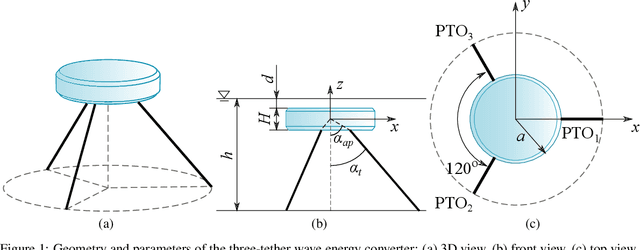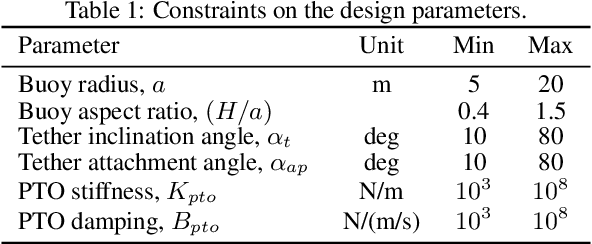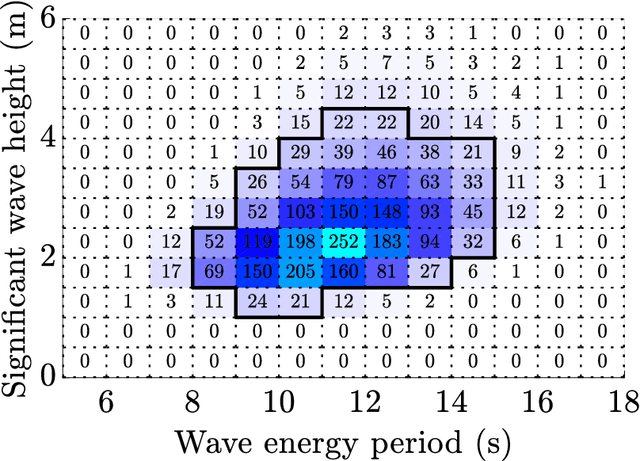Leandro S. P. da Silva
Hybrid Wave-wind System Power Optimisation Using Effective Ensemble Covariance Matrix Adaptation Evolutionary Algorithm
May 28, 2025Abstract:Floating hybrid wind-wave systems combine offshore wind platforms with wave energy converters (WECs) to create cost-effective and reliable energy solutions. Adequately designed and tuned WECs are essential to avoid unwanted loads disrupting turbine motion while efficiently harvesting wave energy. These systems diversify energy sources, enhancing energy security and reducing supply risks while providing a more consistent power output by smoothing energy production variability. However, optimising such systems is complex due to the physical and hydrodynamic interactions between components, resulting in a challenging optimisation space. This study uses a 5-MW OC4-DeepCwind semi-submersible platform with three spherical WECs to explore these synergies. To address these challenges, we propose an effective ensemble optimisation (EEA) technique that combines covariance matrix adaptation, novelty search, and discretisation techniques. To evaluate the EEA performance, we used four sea sites located along Australia's southern coast. In this framework, geometry and power take-off parameters are simultaneously optimised to maximise the average power output of the hybrid wind-wave system. Ensemble optimisation methods enhance performance, flexibility, and robustness by identifying the best algorithm or combination of algorithms for a given problem, addressing issues like premature convergence, stagnation, and poor search space exploration. The EEA was benchmarked against 14 advanced optimisation methods, demonstrating superior solution quality and convergence rates. EEA improved total power output by 111%, 95%, and 52% compared to WOA, EO, and AHA, respectively. Additionally, in comparisons with advanced methods, LSHADE, SaNSDE, and SLPSO, EEA achieved absorbed power enhancements of 498%, 638%, and 349% at the Sydney sea site, showcasing its effectiveness in optimising hybrid energy systems.
Design optimisation of a multi-mode wave energy converter
Jan 24, 2020



Abstract:A wave energy converter (WEC) similar to the CETO system developed by Carnegie Clean Energy is considered for design optimisation. This WEC is able to absorb power from heave, surge and pitch motion modes, making the optimisation problem nontrivial. The WEC dynamics is simulated using the spectral-domain model taking into account hydrodynamic forces, viscous drag, and power take-off forces. The design parameters for optimisation include the buoy radius, buoy height, tether inclination angles, and control variables (damping and stiffness). The WEC design is optimised for the wave climate at Albany test site in Western Australia considering unidirectional irregular waves. Two objective functions are considered: (i) maximisation of the annual average power output, and (ii) minimisation of the levelised cost of energy (LCoE) for a given sea site. The LCoE calculation is approximated as a ratio of the produced energy to the significant mass of the system that includes the mass of the buoy and anchor system. Six different heuristic optimisation methods are applied in order to evaluate and compare the performance of the best known evolutionary algorithms, a swarm intelligence technique and a numerical optimisation approach. The results demonstrate that if we are interested in maximising energy production without taking into account the cost of manufacturing such a system, the buoy should be built as large as possible (20 m radius and 30 m height). However, if we want the system that produces cheap energy, then the radius of the buoy should be approximately 11-14~m while the height should be as low as possible. These results coincide with the overall design that Carnegie Clean Energy has selected for its CETO 6 multi-moored unit. However, it should be noted that this study is not informed by them, so this can be seen as an independent validation of the design choices.
 Add to Chrome
Add to Chrome Add to Firefox
Add to Firefox Add to Edge
Add to Edge